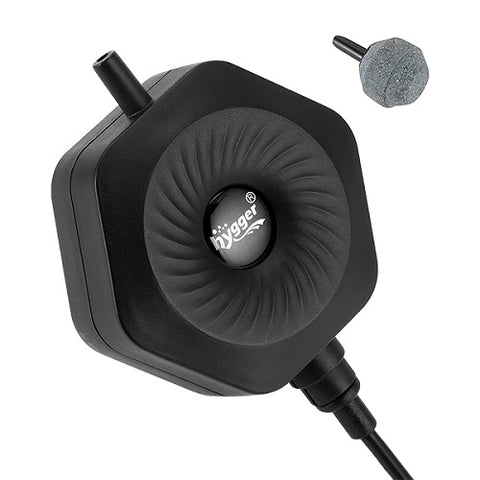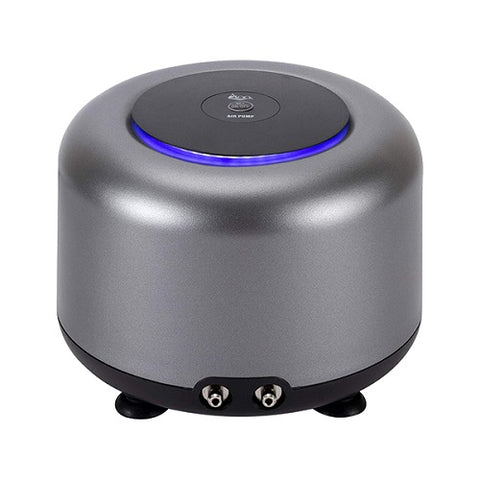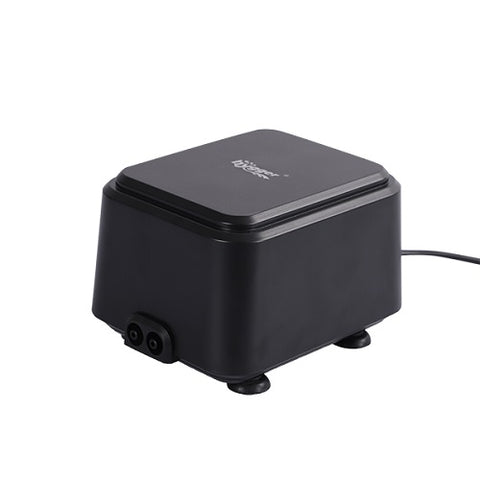What is an air pump?
You may have seen fish bubbling on the water surface. The reason is that they can’t get enough oxygen in the water, and they need to get oxygen from the air.
An air pump is a device that pumps air into the aquarium to meet the oxygen demands of your fish. It will create bubbles, which can promote the movement of the water, as well as surface agitation.
Surface agitation is vital to the air exchange in an aquarium, it will release the excess carbon dioxide to the air and dissolve oxygen from the air into the water to help fish breathe.

Does my fish tank need an air pump?
Having known the function of an air pump, you may wonder is it necessary to buy an air pump. On most occasions, the answer is no. You don’t have to buy an air pump for your aquarium. But in the following circumstances, you may need one.- The filter you use requires an air pump, such as sponge filter.
- Some decorations in your aquarium need an air pump.
- You or your fish like the bubble an air pump creates.
How to set up an air pump?
Step 1 Get your tools ready
The tools you need include an air tube, an air pump, an air stone, a check valve. Before you use these tools, do remember to disinfect them.

Step 2 Place the air pump in a proper position
The air pump should be put outside the tank because it is not waterproof. Find a place where the air pump can be higher than your fish tank to prevent water leakage.
Step 3 Connect the air tubing to the pump
The air tubing should be long enough so it can reach the inside of the aquarium. This step is very simple, you just need to connect them
Step 4 Connect the air tubing to an air stone
The air stone should be put under the water in your aquarium.
Step 5 Add a check valve
If your air pump is placed lower than your tank, there may be a water leakage, so you may need a check valve. A check valve can prevent water from going back to the air pump while allowing the air to go through.
Step 6 Plug the air pump
Once you have got everything ready, you can plug the air pump into a power supply to start it.
How to make an air pump quieter?
Everyone wants a super silent air pump, but it’s difficult to realize. You may find it hard to eliminate the sound your air pump makes, but there are many methods you can lower the noise.
Clean the air stone or other decorations
An air stone and other decorations can lower the noise an air pump creates. So if you find the noise is louder than before, you can try to clean the air stone or the decorations to make them work better in lowering noise.
Place the air pump higher than the water surface
Not only can it prevent water leakage, but also lower the noise. If placed under the water surface, it will cost the air pump more power to pump air. Being placed higher than the water surface, the air pump can utilize gravity to pump air, which means less stress, so it can work silently.
Place the air pump on a solid surface
A hollow container may amplify the vibrations and make the noise even louder while a solid surface can dampen them.
Place the air pump on something soft
This can also dampen the vibrations. You can use a sponge, some cloths, foam or any other soft materials to make the air pump quieter.
Types of air pumps
Plug-in air pumps
This type is the most common one, you can buy it from any aquarium store. Once you plug the air pump into a power supply, it will start to work until you unplug it.
Battery-operated air pumps
Battery-operated air pumps do not need a power supply to plug into, they run on batteries, the only thing you need to do is to change the batteries when they deplete.
Battery backup air pumps
This type is a combination of the above two types. The battery backup air pumps will run after you plug them in a power supply. When there is a power outage, it will still run with the battery backup.
Recommended air pumps
1. Hygger Super Quiet Air Pump for Aquariums
- Adjustable air pump
- Double air outlets
- Energy-saving
- Noise reduction motor
- 8 bottom rubber shock absorber feet to reduce vibration of the pump body and bearing surface
Hygger Aquarium Hexagon Air Pump with Accessories
- Double-side suction cups
- Energy-saving
- Ultra-silent
- Super small body and lightweight
- Unique private patent design
- Easy to install and use

AQQA Rounded Aquarium Air Pump for Freshwater and Saltwater
- Fit for freshwater
- Stainless steel outlets
- Ultra-quiet
- Large volume oxygen pump
- Energy-saving
- Adjustable four-stage flow rate
- Double air outlet

What to look for in an aquarium air pump
Size
The size of an air pump may vary, you should choose the right size according to the space you have. If there is enough space in your room, you can consider a large air pump, but if your space is limited, try a smaller one that can be hidden away.
Noise
Fish are sensitive creatures, too loud noise will make them stressed and some of them may become aggressive. Also, the loud noise will influence our daily life, making us feel restless. When choosing an air pump, choose the quietest one.
Price
People say you get what you pay for, but sometimes our budget can not afford an expensive but good air pump. In that case, try to buy the most expensive one you can afford because its quality may be better than those cheaper ones.



Comments (0)
Back to Supplies & Equipment